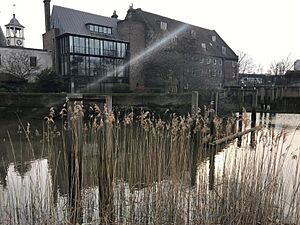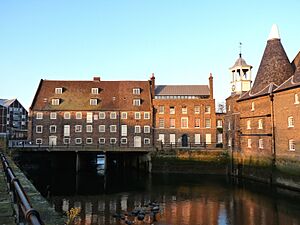Three Mills facts for kids
Quick facts for kids Three Mills |
|
|---|---|
 The Clock Mill at Three Mills |
|
| London borough | |
| Ceremonial county | Greater London |
| Region | |
| Country | England |
| Sovereign state | United Kingdom |
| Post town | LONDON |
| Postcode district | E3 |
| Dialling code | 020 |
| Police | Metropolitan |
| Fire | London |
| Ambulance | London |
| EU Parliament | London |
| London Assembly | |
The Three Mills are a very old industrial area in London, located on an island next to the River Lea. This place is one of London's oldest working industrial sites! Even though it's on the Newham side of the river, you usually get there from the Tower Hamlets side.
The River Lea Tidal Mill Trust Ltd owns two important buildings here: the House Mill and the Miller's House. They use these buildings for fun educational projects and as places for meetings. A project called the Lower Lea Project also works from the Miller's House at Three Mills.
Contents
History of Three Mills
Ancient Mills and Their Purpose
People think there were about eight or nine mills on the River Lea in Stratford a very long time ago, around the time the Domesday Book was written. The Domesday Book was like a big survey ordered by King William the Conqueror to record everything in England. These mills were some of the first to use the power of the tides to work! The Clock Mill alone had 16 workers.
A place called Stratford Langthorne Abbey, which was built in 1135, got control of Three Mills in the 12th or 13th centuries. The area then became known by the name "Three Mills." By the 1530s, when King Henry VIII closed down many abbeys, these mills were grinding flour for the bakers of Stratford-atte-Bow. These bakers were famous for their amazing bread, which they sold in the huge City of London market.
In 1588, one of the mills was even used to make gunpowder! During the 16th century, the three mills became just two: the House Mill and the Clock Mill. Later, in the 17th century, the mills started grinding grain to make alcohol. They became a huge supplier for London's alcohol trade and its many "gin palaces" (fancy places where people drank gin).
Building and Changes Over Time
The House Mill was first built in 1776. After a fire, it was quickly rebuilt. It's now a "Grade I listed building," which means it's super important historically and protected. The Clock Mill was rebuilt between 1815 and 1817 by Philip Metcalfe. He kept the old clock and an older bell. There was also a windmill here, but it was gone by about 1840. The House Mill kept working until 1940, and the Clock Mill until 1952.
The ownership of Three Mills changed many times until 1872. That's when gin makers J&W Nicholson & Co bought it. They started making their gin there. Eventually, all their gin production moved to Three Mills. But during World War II, in 1941, they stopped making alcohol because of shortages. The Nicholson family later sold the business to another company.
Three Mills was badly damaged by air raids during the Second World War. The Miller's House was destroyed in 1941 but rebuilt in 1995. It has a modern inside but still looks like the original from the front. Three Mills was also used for bottling drinks and as a storage place by other companies. One of the oldest wine merchants in Britain, Hedges & Butler, had their main offices here. They bottled Bacardi and sold many different wines and spirits.
The House Mill is still the biggest tidal mill in the world, even though its water wheels aren't working right now. The River Lea Tidal Mill Trust Ltd owns the building, and you can visit it on Sunday afternoons in the summer. It's one of only four Grade I listed buildings in the London Borough of Newham.
For the 2012 Summer Olympics, a new lock called the Three Mills Lock was built on the Prescott Channel. This created a higher water level behind the mill. This might mean the mill can work again, even though it changed some of the natural tidal flow.
The Clock Mill is currently home to the East London Science School. In 2017, J&W Nicholson brought back their original gin brand, Nicholson Gin, which first started in 1736.
Three Mills Island: A Special Place
Three Mills Island is located in Bromley-by-Bow in east London. It's part of the 50-mile Lea Valley Walk, a popular walking path that has been featured in newspapers like The Telegraph and The Guardian.
The Prescott Channel, which helps control floods, runs to the east of the land, making it an island. The mills share Three Mills Island with the 3 Mills Studios. This is a large 10-acre film and TV studio where many big movies and TV shows are made! There's also an open green space and play area called Three Mills Green.
Across from the mills, there's a 26-acre area that used to be called the Three Mills District. This area once had a large cooperage (a place that made barrels) to support the mills. It also had many other businesses, from making special inks to refining sugar. This area is now being developed into a place called Sugar House Island. It will create 2,500 jobs with new businesses, homes by the water, and fun places to visit.
How the Mills Worked
In 1878, Three Mills had seven waterwheels. Most of them were about 20 feet tall and 3 feet wide, but one was 8 feet wide! The House Mill had four waterwheels, and the Clock Mill had three. These wheels powered fourteen pairs of millstones, which are big grinding stones. Together, they made a total of 150 horsepower. The House Mill could grind about 2 tons of maize and 5 tons of barley with each tide. On very strong tides, it could grind even more, up to 10 and 14 tons! The two mills together could process about 125 tons of grain every week.
The Clock Mill used three iron water wheels to work. These wheels turned six pairs of millstones very fast, at 130 rotations per minute. This mill kept working until 1952. When both mills were running in 1938, the site had one millwright (a person who builds and fixes mills) and four carpenters. During the 7-8 hours of tidal power each day, the water wheels turned at 16 rotations per minute. This power was enough to turn each millstone and grind the grain.






